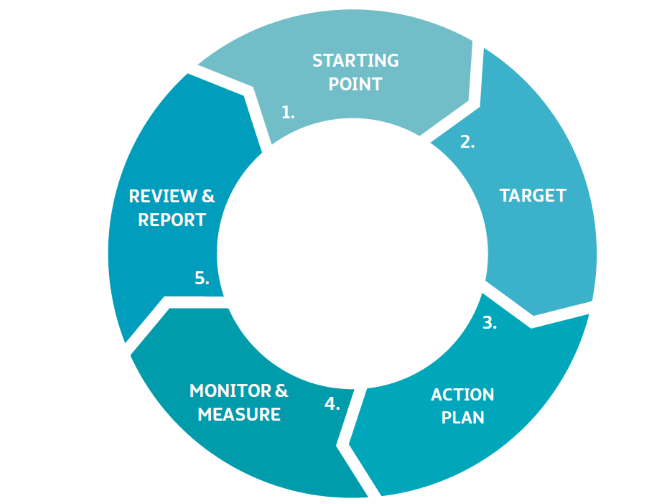Guide to Water Conservation - PDF Download
How to save water, lower emissions and reduce costs in your tourism business
Text-to-speech reader:
Business Guidance
Part 2: A Leaner & Greener Roadmap

Assuming that managerial support exists, the diagram below shows a good approach to energy management. You will see that it is the same cycle that would apply to the management of any process or system within your business.

|
Step 1 : Appoint a Green Champion or Green Team |
|
Appointing a Green Champion or a Green Team is the very first step in saving energy and costs. In a small business, one person may be responsible for this – a Green Champion. In a larger business, it is wise to bring a team of people together – a Green Team. They must have both the responsibility and authority to drive your cost-saving and carbon-saving ambitions. Team members may also need training, meetings, resources and above all time to lead through the rest of the steps below. |
|
Step 2 : Gather data on Annual Water Use (m3) and Water Cost (£) in your business |
|
The very first job of your Green Champion or Green Team is to establish your Starting Point i.e. find out how much water, in cubic metres (m3), that your business used in the last year and how much that water cost (£). You can get this information by reviewing your water bills for the previous year. (Log this data in the Water Use & Costs Template - see Section 4.1) Tip: If you need help reading your bill, visit NI Water | Understanding your bill |
|
Step 3: Establish your benchmark against which you will measure future performance |
|
Benchmarking allows you to track water use over time. It allows you track your own performance and also to compare your business against others. When you have worked out your annual costs and consumption, you can establish m3 and cost per person/per metre/per cover/per room/per ticket – whichever benchmark is the most relevant for your business and that you can track consistently over time. (Enter your Benchmark Measure in the Water Use & Costs template see Section 4.1) Tip: Make note of how you calculate your benchmark so that you and other team members calculate it in the same way each time. This is the only way to ensure you have comparable data. |
|
Step 4: Conduct a Water Audit |
|
You need to understand where water is used in your business and how water is used in your business. A Water Audit will help you do this. There are three elements in the Water Audit: i. List water-using equipment, inside and out |
|
Step 5: Analyse data and develop your Water Action Plan |
|
By now, you will have great information on where and how water is used in your business, as well as how much it costs. Once you know which equipment and operations use the most water, determine the best ways to cut that use without impacting the business. The plan should include immediate and short-term actions as well as medium to long-term ones. It is important to set goals that are specific and measurable. Be clear on who is responsible for each action and the deadline by which it is to be complete. |
The Water Flow Rate is the speed at which water flows out of a tap, shower or toilet in litres per minute.
If you identify the flow rate of your water-using equipment, you can compare it to best practice flow rates. This will allow you to see if equipment is using more water than it should and to calculate the savings you might make if you adapted or replaced that piece of equipment.
(Source: Environmental Protection Agency, Ireland)
Flow Rate x Estimated Minutes in Use Per Week |